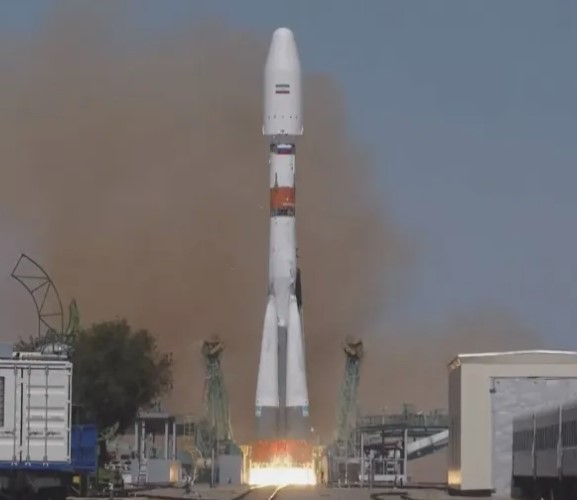Russia’s space agency, Roscosmos, has recently achieved a significant milestone with the launch of a Soyuz-2.1 rocket from the Vostochny Cosmodrome, located in eastern Russia. The rocket carried a dual-purpose mission with a variety of payloads.
Russia’s Soyuz Rocket Launches New Space Weather Satellites
The primary focus of this mission was to place two advanced Ionosfera-M satellites into orbit, which are specifically designed to study and monitor space weather. Additionally, this mission carried 53 smaller satellites, including two from Iran, in an effort to advance Russia’s collaboration with international partners in space research.
The Ionosfera-M satellites, each weighing approximately 430 kilograms, were launched aboard the Soyuz rocket into an orbit around 820 kilometers above Earth’s surface. These satellites play an essential role in understanding the ionosphere, a layer of Earth’s atmosphere that stretches from roughly 80 to 640 kilometers (50 to 400 miles) above the planet. This region is where the atmosphere meets space, and it has a significant impact on various technological systems.
The ionosphere affects satellite navigation, long-distance radio communication, and other space-based operations, as solar radiation and space weather constantly alter its properties.
NASA and space scientists globally have underscored the importance of studying the ionosphere. Variations in this layer can disrupt communication systems and even affect the functioning of satellites. With Roscosmos using the Soyuz rocket to launch these crucial Ionosfera-M satellites, this mission marks an important step in expanding our understanding of space weather. Russia plans to deploy two more Ionosfera-M satellites aboard a future Soyuz mission in 2025, completing a constellation of four, which will enhance the capacity to monitor changes within the ionosphere and aid in developing more accurate space weather forecasts.
Patriot Missiles Decimate Russia’s Advanced Su-35 Fighter in Ukraine Conflict
Iran’s First Private Sector Satellites Launched by Russia
As part of the 53 smaller satellites deployed during this mission, Iran launched two private-sector satellites, Kowsar and Hodhod, which signify the first Iranian satellites privately financed and developed. Kowsar is designed to capture high-resolution images of Earth, a capability that can aid in observing environmental changes, monitoring agriculture, and managing natural resources. Hodhod, on the other hand, is a communication satellite that aims to enhance Iran’s telecommunications and data transfer capabilities.
This launch represents another example of Iran’s ongoing progress in the space sector, especially in collaboration with Russia. Iran has previously relied on Russian assistance to place its satellites in orbit. Notable earlier collaborations include the Khayyam satellite, an Earth observation satellite launched in 2022, and the Pars-I satellite, launched earlier this year. These partnerships have been crucial for Iran as it faces challenges in independently reaching orbit.
New Twist: North Korean Forces Enter Russia as War Intensifies
Cooperation Amidst Political Tensions
The cooperation between Moscow and Tehran in space technology continues to grow, even as both nations face sanctions and international scrutiny. This partnership has gained attention due to allegations from Western countries and Ukraine that Iran is supplying drones to Russia for military operations in Ukraine. Both Russia and Iran have denied these claims, maintaining that their partnership remains focused on peaceful endeavors such as satellite launches and space exploration.
Final Blow? Israel’s Strike in Iran Aims to End Escalating Tit-for-Tat!
Iran’s recent successes with Russia come despite difficulties within its own civilian space program. Iran has experienced a series of setbacks, particularly with the Simorgh satellite program, which endured five consecutive launch failures. In 2019, a tragic accident on an Iranian launchpad caused the loss of three researchers, highlighting the risks associated with space exploration. Furthermore, recent satellite imagery suggested that an Israeli airstrike targeted an Iranian military facility reportedly linked to the Iranian Revolutionary Guard’s space program.
The United States has expressed concerns over Iran’s satellite launch technology, cautioning that it may serve as a pathway toward developing intercontinental ballistic missiles (ICBMs). These missiles have the capability to travel long distances and potentially carry nuclear warheads. After the collapse of the 2015 nuclear agreement, Iran began enriching uranium to levels approaching what would be necessary for weapons production. This activity has drawn warnings from the International Atomic Energy Agency (IAEA), which states that Iran could theoretically use its enriched uranium for nuclear weapons if it chose to pursue such a path.

